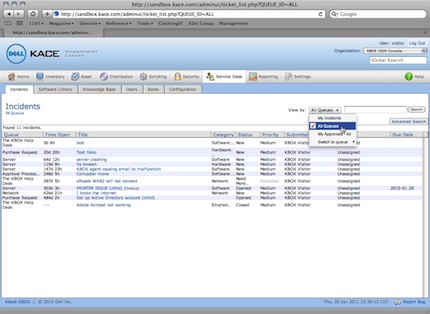Rescuing the Help Desk
- By Bridget McCrea
- 01/20/11
Five years ago Charlotte School of Law was the new kid on the block in North Carolina's higher education system. The institution opened its doors with 66 students and big aspirations in 2006. With such a small stable of teachers and students to serve, Charlotte School of Law's four-person IT team handled all support requests manually.
Then the school started growing, and the manual process got harder to manage. With no room in the institution's budget for additional IT staff, Ryan Haylock, director of IT, began searching for a better way to handle manual asset inventory, patch management, software update services, and related functions.
"About 40 percent of the IT team's time was spent attending to helpdesk tasks," said Haylock, "with another 20 percent consumed by configuration management, physical inventory, and auditing."
Recognizing the inefficiencies in those manual systems, Haylock said, he looked around for an automated helpdesk solution. "I knew we needed something, but I wasn't sure what was out there, and what type of solution would meet the needs of our growing school," he said. Initially, Haylock considered free networking monitoring solutions like Spiceworks and NumeriTrack, but soon realized that the institution needed a system with more teeth.
"I started looking across solutions that could handle more than just incident management," explained Haylock, who kept the school's potential growth, and budget consciousness, in mind when shopping around. He also focused on simplicity, with the goal of "having as few systems handling as many tasks as possible," he said. "I wanted a one-stop-shop, and wasn't interested in something that had multiple interfaces that would require extensive staff training."
After getting approval from the institution's finance department, Haylock ultimately decided on the Dell KACE K1000 management appliance. The plug-and-play device was installed and deployed to 200 campus PCs within about 45 minutes. Installation entailed hooking the device up to the school's network and inputting the IP address ranges of the campus desktops.

The integrated help desk solution links with other functionality available through the KACE 1000 appliance (software distribution, inventory, patch management, etc.) to assist with troubleshooting. |
"It installed clients on every one of those machines and started gathering inventory," said Haylock. "Forty-five minutes later, we were managing all of the PCs."
For Charlotte School of Law's IT team, the system handles tasks like device discovery and inventory, software distribution, configuration and policy management, patch management (for Microsoft, Adobe, and any other software programs in use on campus), security audit and enforcement, and asset management. Reports are delivered to the IT team, which can see how many of the PCs are in compliance and which need attention.
"Every now and then we push scripts out to the machines through the device," said Haylock. "We also rely on it for asset inventory. If a computer goes missing, we get reports and can take action." The IT team can also actively examine the computers on campus to see, for example, whether any are running low on hard drive space. Budget cycles and upgrades are easier to manage, as are tasks like system imaging and server maintenance.
With an incoming class of more than 400 students for the 2010-2011 school year--and 800 pupils total--Charlotte School of Law's IT team is well equipped to deal with user support requests. Just two staff members have been added since 2007, said Haylock, yet the team has reduced the time spent on helpdesk issues by 60 percent during that period. He had estimated the one-year return on investment to be about $400,000 (namely in time savings for the IT staff, which can now focus on other projects), and said it was achieved within 30 days of installation.
The fact that the school's IT team now works actively--instead of being in constant "reactionary" mode--is one of the biggest benefits of having an automated helpdesk. "With our previous, manual process, we didn't have the time or resources to do reporting, or take any proactive steps," said Haylock. "User satisfaction is much higher now because we can track trends, work on upgrades, and resolve issues quickly."
The helpdesk system hasn't been upgraded or changed much since installed in 2007, although the solution was introduced to one of Charlotte Law School's sister institutions, Phoenix School of Law, based on the former's success using it. "They're in the process of rolling that out right now," said Haylock, "based on the good results we've experienced using the device."
Haylock, whose current IT agenda includes a new online, content management system, and the installation of SharePoint to host intranet-based Web pages, said the growing law school plans to continue implementing new solutions that fit with his "as few systems as possible handling the highest number of tasks," philosophy. "The question is, what aren't we doing here when it comes to IT?" he said. "There's always something on the planning table or in the works. It doesn't stop."
| Editor's note: This article has been modified since its original publication to correct a factual error. We erroneously reported that Charlotte School of Law was the first law school in North Carolina. That is not the case. It was beaten out for that distinction by University of North Carolina School of Law by approximately 161 years. [Last updated Jan. 20, 2010 at 4:47 p.m.] --David Nagel |